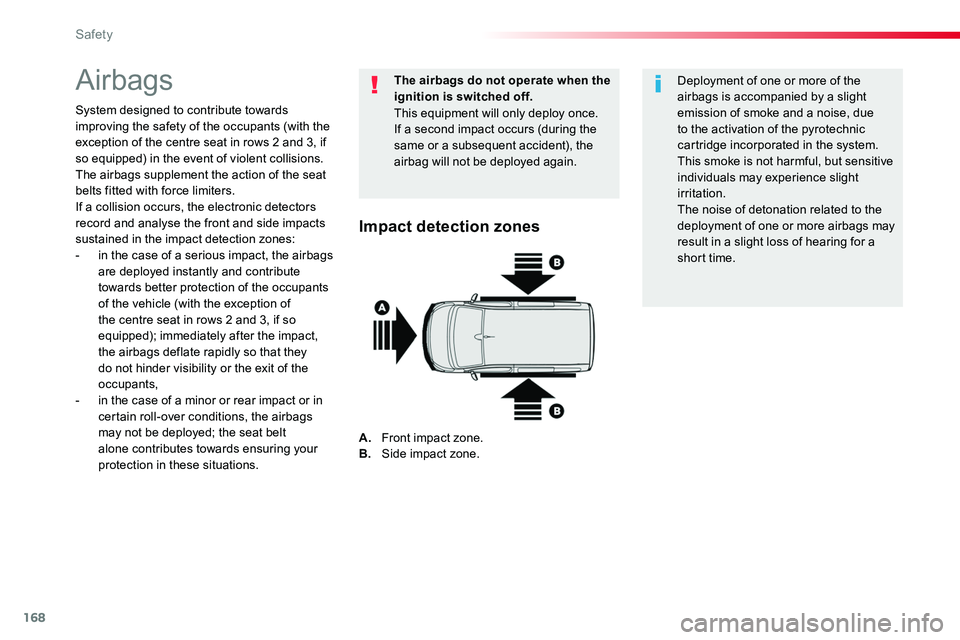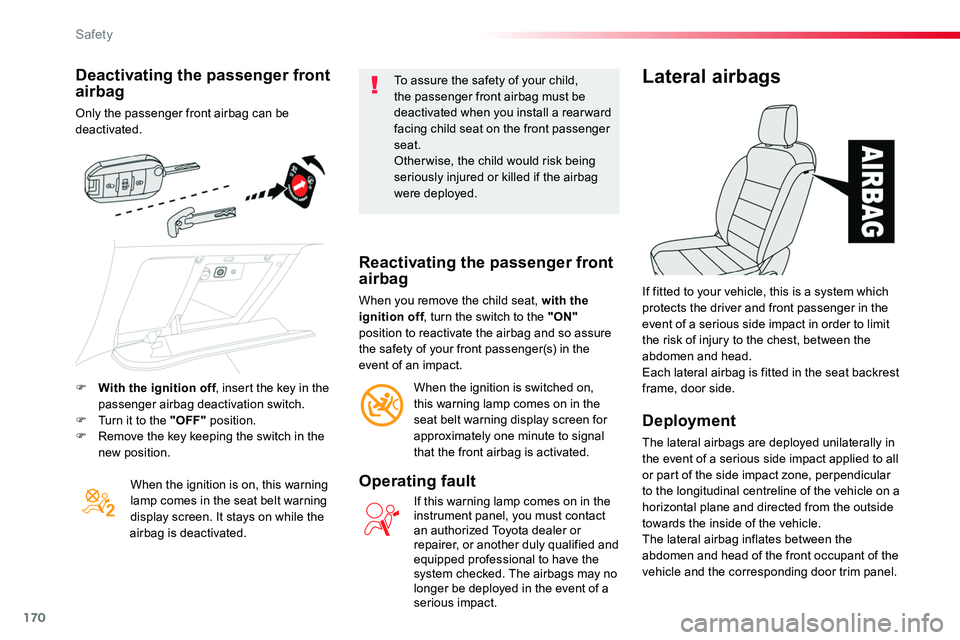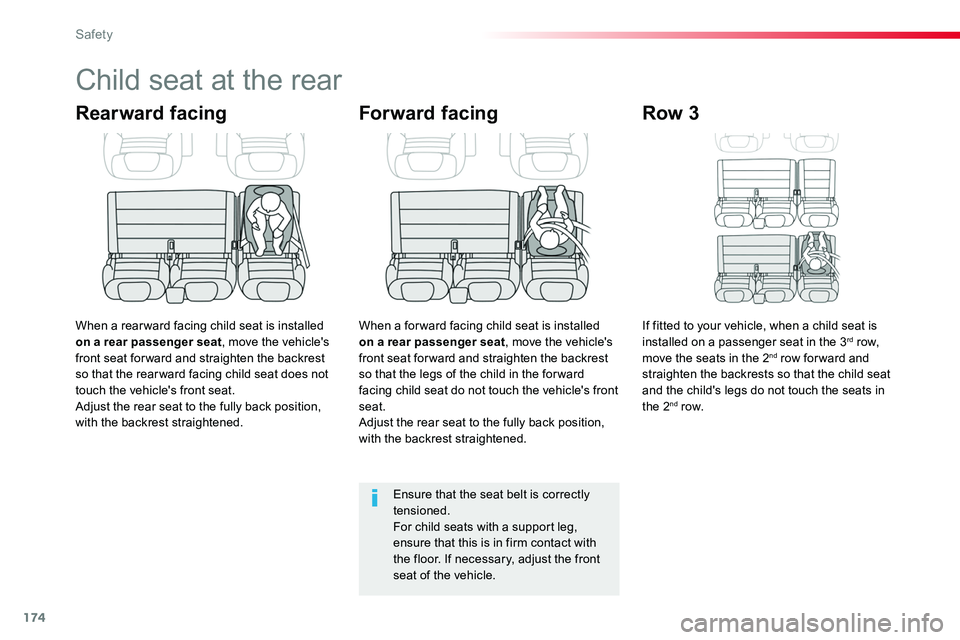Page 168 of 504

168
Airbags
System designed to contribute towards improving the safety of the occupants (with the exception of the centre seat in rows 2 and 3, if so equipped) in the event of violent collisions. The airbags supplement the action of the seat belts fitted with force limiters.If a collision occurs, the electronic detectors record and analyse the front and side impacts sustained in the impact detection zones:- in the case of a serious impact, the airbags are deployed instantly and contribute towards better protection of the occupants of the vehicle (with the exception of the centre seat in rows 2 and 3, if so equipped); immediately after the impact, the airbags deflate rapidly so that they do not hinder visibility or the exit of the occupants,- in the case of a minor or rear impact or in certain roll-over conditions, the airbags may not be deployed; the seat belt alone contributes towards ensuring your protection in these situations.
The airbags do not operate when the ignition is switched off.
This equipment will only deploy once. If a second impact occurs (during the same or a subsequent accident), the airbag will not be deployed again.
Deployment of one or more of the airbags is accompanied by a slight emission of smoke and a noise, due to the activation of the pyrotechnic cartridge incorporated in the system.This smoke is not harmful, but sensitive individuals may experience slight irritation.The noise of detonation related to the
deployment of one or more airbags may result in a slight loss of hearing for a short time.
Impact detection zones
A. Front impact zone.B. Side impact zone.
Safety
Page 170 of 504

170
Deactivating the passenger front airbag
Only the passenger front airbag can be deactivated.
When the ignition is on, this warning lamp comes in the seat belt warning display screen. It stays on while the airbag is deactivated.
To assure the safety of your child, the passenger front airbag must be deactivated when you install a rear ward facing child seat on the front passenger seat.Other wise, the child would risk being seriously injured or killed if the airbag were deployed.
Reactivating the passenger front airbag
When you remove the child seat, with the ignition off, turn the switch to the "ON" position to reactivate the airbag and so assure the safety of your front passenger(s) in the event of an impact.
When the ignition is switched on, this warning lamp comes on in the seat belt warning display screen for approximately one minute to signal that the front airbag is activated.
Operating fault
If this warning lamp comes on in the instrument panel, you must contact an authorized Toyota dealer or repairer, or another duly qualified and equipped professional to have the system checked. The airbags may no longer be deployed in the event of a serious impact.
Lateral airbags
Deployment
The lateral airbags are deployed unilaterally in the event of a serious side impact applied to all or part of the side impact zone, perpendicular to the longitudinal centreline of the vehicle on a horizontal plane and directed from the outside towards the inside of the vehicle.
The lateral airbag inflates between the abdomen and head of the front occupant of the vehicle and the corresponding door trim panel.
If fitted to your vehicle, this is a system which protects the driver and front passenger in the event of a serious side impact in order to limit the risk of injury to the chest, between the abdomen and head.Each lateral airbag is fitted in the seat backrest frame, door side.F With the ignition off, insert the key in the passenger airbag deactivation switch.F Turn it to the "OFF" position.F Remove the key keeping the switch in the new position.
Safety
Page 172 of 504

172
Sit in a normal upright position.Wear a correctly adjusted seat belt.Do not leave anything between the occupants and the airbags (a child, pet, object...), nor fix or attach anything close to the inflation trajectory of the airbags; this could cause injuries during their deployment.Never modify the original definition of your vehicle, particularly in the area directly around the airbags.After an accident or if the vehicle has been stolen or broken into, have the airbag systems checked.All work on the airbag system must be carried out by an authorized Toyota dealer or repairer, or another duly qualified and equipped professional.Even if all of the precautions mentioned are observed, a risk of injury or of minor burns to the head, chest or arms when an airbag is deployed cannot be ruled out.
Lateral airbags
Use only approved covers on the seats, compatible with the deployment the lateral airbags. For information on the range of seat covers suitable for your vehicle, you can contact an authorized Toyota dealer or repairer, or another duly qualified and equipped professional.For more information on Accessories, refer to the corresponding section.Do not fix or attach anything to the seat backs (clothing...). This could cause injury to the chest or arms if the lateral airbag is deployed.Do not sit with the upper part of the body any nearer to the door than necessary.
The bag inflates almost instantly (within a few milliseconds) then deflates within the same time discharging the hot gas via openings provided for this purpose.
Front airbags
Do not drive holding the steering wheel by its spokes or resting your hands on the centre part of the wheel.Passengers must not place their feet on the dashboard.Do not smoke as deployment of the airbags can cause burns or the risk of injury from a cigarette or pipe.Never remove or pierce the steering wheel or hit it violently.Do not fit or attach anything to the steering wheel or dashboard, this could cause injuries with deployment of the airbags.
Advice
For the airbags to be fully effective, observe the safety recommendations below:
Curtain airbags
Do not fix or attach anything to the roof. This could cause injury to the head if the curtain airbag is deployed.If fitted on your vehicle, do not remove the grab handles installed on the roof, they play a part in securing the curtain airbags.
Safety
Page 173 of 504
173
General points relating to child seats
For maximum safety, please observe the following recommendations:- in accordance with European regulations, all children under the age of 12 or less than one and a half metres tall must travel in approved child seats suited to their weight, on seats fitted with a seat belt or ISOFIX mountings*,- statistically, the safest seats in your vehicle for carr ying children are the rear seats,- a child weighing less than 9 kg must travel in the rear ward facing position both in the front and in the rear.
To y o t a recommends that children should travel on the rear seats of your vehicle:- rearward facing up to the age of 3,
- forward facing over the age of 3.
Although one of Toyota's main criteria when designing your vehicle, the safety of your children also depends on you.
* The regulations on carrying children are specific to each country. Refer to the legislation in force in your country.
5
Safety
Page 174 of 504

174
Child seat at the rear
Rearward facing
When a rear ward facing child seat is installed on a rear passenger seat, move the vehicle's front seat for ward and straighten the backrest so that the rear ward facing child seat does not touch the vehicle's front seat.Adjust the rear seat to the fully back position, with the backrest straightened.
Forward facing
When a for ward facing child seat is installed on a rear passenger seat, move the vehicle's front seat for ward and straighten the backrest so that the legs of the child in the for ward facing child seat do not touch the vehicle's front seat.Adjust the rear seat to the fully back position, with the backrest straightened.
Ensure that the seat belt is correctly tensioned.For child seats with a support leg, ensure that this is in firm contact with the floor. If necessary, adjust the front seat of the vehicle.
Row 3
If fitted to your vehicle, when a child seat is installed on a passenger seat in the 3rd row, move the seats in the 2nd row for ward and straighten the backrests so that the child seat and the child's legs do not touch the seats in the 2nd row.
Safety
Page 175 of 504
175
Passenger seat in the fully back and highest position.
Rearward facing
Child seat at the front*
Forward facing
Ensure that the seat belt is correctly tensioned.For child seats with a support leg, ensure that the support leg is in firm and stable contact with the floor. If necessary, adjust the passenger seat.
When a rear ward facing child seat is installed on the front passenger seat, adjust the seat to the fully back and highest position, with the backrest straightened.The passenger's front airbag must be deactivated. Otherwise, the child risks being seriously injured or killed if the airbag is deployed.
When a for ward facing child seat is installed on the front passenger seat, adjust the vehicle's seat to the fully back and highest position with the seat backrest straightened and leave the passenger's front airbag activated.
* Refer to the legislation in force in your country before carrying your child in this seating position.
5
Safety
Page 179 of 504
179
Child seats recommended by Toyota
Toyota offers a range of child seats which are secured using a three point seat belt.
Group 0+: from bir th to 13 kg
L1 "TOYOTA GO + BABYSAFE PLUS"Installed rearward facing.
5
Safety
Page 180 of 504
180
Groups 2 and 3: from 15 to 36 kg
L5 "TOYOTA KIDIFIX XP SICT" Can be fitted to the vehicle's ISOFIX mountings.The child is restrained by the seat belt.
L6 "TOYOTA DUO PLUS"The child is restrained by the seat belt.
Safety